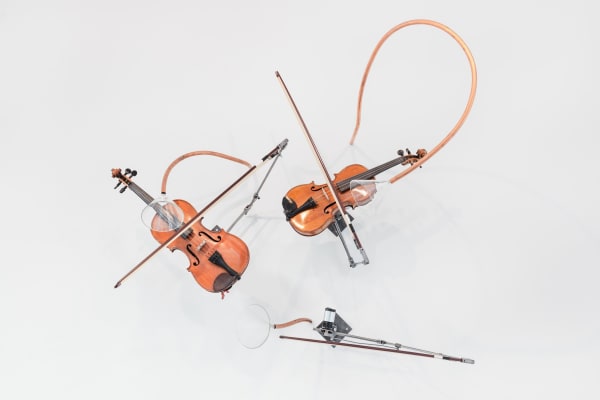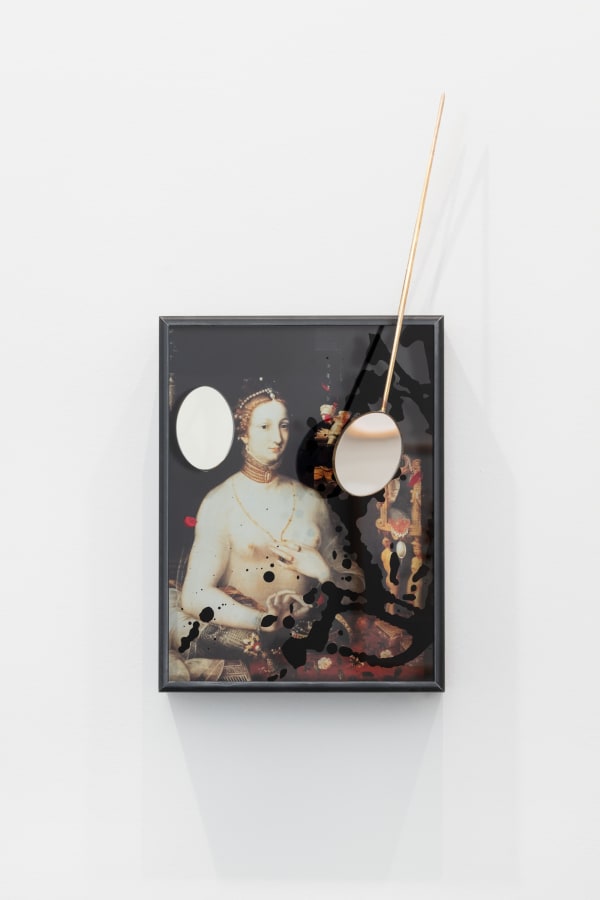As part of this year’s Gallery Weekend Berlin, Galerie Thomas Schulte presents a solo exhibition by Rebecca Horn. Alongside Horn’s recent works, the gallery is also showing two of the artist’s seminal kinetic installations from the 1990s: Bees' Planetary Map (1998) and Der Turm der Namenlosen (1994). Thomas Schulte’s very first exhibition at the time of the gallery’s opening on Momsensenstraße—Berlin-Charlottenburg—in April 1991, featured Rebecca Horn’s unforgettable installation Chor der Heuschrecken (Choir of Locusts). 30 years and many joint projects later, the gallery continues its active collaboration with one of Germany’s most important female artists.
In 1991, Rebecca Horn created her work Chor der Heuschrecken I, II for Galerie Thomas Schulte. This was the first time a sculptural choreography connected two spaces—and later, two places—in a landscape-like manner. This approach would also become form-defining for Horn’s work. So too would the insect: negotiating liminal positions between life and death with its spatial sensors and seismographic perception.
We find this leitmotif in Bees' Planetary Map (1998). The piece, at once site-specific, and yet not bound to any one space, captures the transformative power of bees: converting and repurposing natural substances to construct their habitats. Conceived during the height of the Balkans war, which forcibly displaced millions across the region, Bees' Planetary Map captures themes of dislocation, uprootedness and fractured movement. Empty beehives fill the space with the haunting buzz of a wandering swarm of bees. Honey-yellow light streams from the suspended baskets, which is in turn reflected off of round, rotating mirrors and projected across walls and ceilings. At regular intervals, a paving stone attached to a mechanical winch falls from the ceiling and shatters one of the mirrors. Spinning splinters of mirror chase panicked scraps of light across the room. Struggling towards the center, searching for protection and security, fearing for freedom and belonging—these are the central human themes in Rebecca Horn’s work.
Themes of flight and (up)rootedness are further visible in Der Turm der Namenlosen (1994). Rebecca Horn dedicated this piece to the thousands of, largely Bosnian, refugees who arrived in Vienna in the early-to-mid 1990s. Most arrived without passports and without knowledge of the dominant language. Many would use the musical instruments they brought with them to express and perform their trauma.
As if trying to escape from the window arches, a spiral of interlocking fruit picking ladders crowd upwards toward the ceiling of the gallery’s Corner Space. Seeming to climb the ladders’ rungs, nine violins begin to play a wild polyphony at regular intervals. The symbolic power of musical instruments—and the string instrument in particular—in contexts of trauma and displacement, has become a central leitmotif in Horn’s work. This particularly true for her piece, Concert for Buchenwald. Created around the same time as Bees’ Planetary Map, this sculptural composition has been on permanent installation in Weimar since 1999. A further leitmotif object in Horn’s work are the spinning binoculars which recur in her ten-part filmography including Der Eintänzer, La Ferdinanda, and Buster’s Bedroom.
Beginning with her early performances and now encompassing drawings, poems, overpainted photographs, stage sets, and paintings as well as her animated sculptures, Rebecca Horn’s oeuvre is continuously formed and reformed by intersecting and mutually reinforcing creative impulses and directions of inquiry. A Centrepiece of her extensive oeuvre is her 1970 performance piece, Unicorn. A female figure extended by a rod; a vertical presence wandering the room, taking measure of the space. It is through her poetic imagination that Rebecca Horn obscures and stretches the figure into infinite depths and heights. In a similar way, the body becomes a central tool in her artistic creation; often measuring the large papers on which she draws according to the length of her arms. Pencil-marked focal points in her paintings, correspond to her own body’s center, and often remain visible in the final piece. In works such as Im Schatten des Schmerzes (In the Shadow of Pain), meanwhile, the lower edge of the painting often takes shape through the implied silhouette of a landscape. Receiving their momentum from this line, streams of energy rise into the air, branch out gradually, and finally condense in a celestial space where they begin to swirl in an ecstatic, rotating dance. Their ascent to this spiritual height, however, is the product of a struggle between gliding, dark and light figures. As viewers, we become unknowing participants; physically imitating the upward and downward movements as we observe the figures’ struggle. As is true for most of Rebecca Horn’s work, the viewer is always implicated in the depiction.
Today, 30 years after its inaugural exhibition on Mommsenstraße, Galerie Thomas Schulte once again opens an exhibition by Rebecca Horn. In this way, on the occasion of this anniversary, the gallery opens up a historical space in which our present appears transported from a past, predetermined vision.














